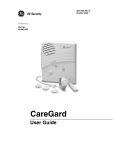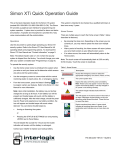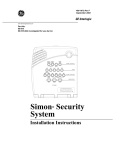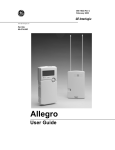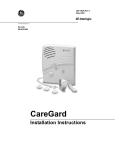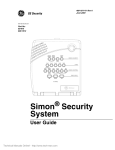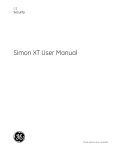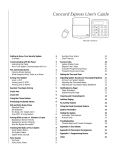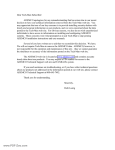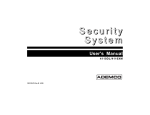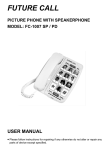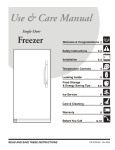Download Manual
Transcript
g 466-1936 Rev C May 2003 GE Interlogix www.GE-Interlogix.com Part No: 60-883-95R CareGard User Guide FCC Notices FCC Part 15 Information to the User Changes or modifications not expressly approved by Interlogix Inc. can void the user’s authority to operate the equipment. FCC Part 15 Class B This equipment has been tested and found to comply with the limits for a Class B digital device, pursuant to part 15 of the FCC Rules. These limits are designed to provide reasonable protection against interference in a residential installation. This equipment generates, uses, and can radiate radio frequency energy and, if not installed and used in accordance with the instructions, may cause harmful interference to radio communications. However, there is no guarantee that interference will not occur in a particular installation. If this equipment does cause harmful interference to radio or television reception, which can be determined by turning the equipment off and on, the user is encouraged to try to correct the interference by one or more of the following measures: • Reorient or relocate the receiving antenna. • Increase the separation between the equipment and receiver. • Connect the affected equipment and the panel receiver to separate outlets, on different branch circuits. • Consult the dealer or an experienced radio/TV technician for help. ACTA Part 68 This equipment complies with Part 68 of the FCC Rules. Located on this equipment is a label that contains, among other information, the FCC registration number and the ringer equivalence number (REN) for this equipment. If requested, this information must be provided to the telephone company. FCC Part 68 Registration No. B4Z-USA-46042-AL-T The REN is used to determine the maximum number of devices that may be connected to your telephone line. Excessive RENs on a telephone line may result in devices not ringing in response to an incoming call. In most areas, the sum of all device RENs should not exceed five (5.0). To be certain of the number of devices that may be connected to a line, as determined by the total RENs, contact the local telephone company. For products approved after July 23, 2001, the REN for this product is part of the product identifier that has the format US:AAAEQ##TXXXX. The digits represented by ## are the REN without a decimal point (e.g., 03 is a REN of 0.3). For earlier products, the REN is separately shown on the label. A plug and jack used to connect this equipment to the premises wiring and telephone network must comply with the applicable FCC Part 68 rules and requirements as adopted by ACTA. A compliant telephone cord and modular plug is provided with this product. It is designed to be connected to a compliant modular jack that is also compliant. See the Installation Instructions for details. Alarm dialing equipment must be able to seize the telephone line and place a call in an emergency situation. It must be able to do this even if other equipment (telephone, answering system, computer modem, etc.) already has the telephone line in use. To do so, alarm dialing equipment must be connected to a properly installed RJ31X jack that is electrically in series and ahead of all other equipment attached to the same telephone line. Proper installation is depicted in the following diagram. If you have any questions concerning these instructions, consult your local telephone company or a qualified installer about installing an RJ31X jack and alarm dialing equipment for you. C u s to m e r P r e m is e s E q u ip m e n t a n d W ir in g N e tw o rk S e r v ic e P r o v id e r 's F a c ilitie s A la r m D ia lin g E q u ip m e n t R J 3 1 X J a c k C o m p u te r U n u s e d R J -1 1 J a c k T e le p h o n e L in e N e tw o rk D e m a r c a tio n P o in t A n s w e r in g S y s te m T e le p h o n e T e le p h o n e F a x M a c h in e U n u s e d R J -1 1 J a c k T e le p h o n e If this equipment causes harm to the telephone network, the telephone company may temporarily disconnect your service. If possible, you will be notified in advance. When advance notice is not practical, you will be notified as soon as possible. You will also be advised of your right to file a complaint with the FCC. The telephone company may make changes in its facilities, equipment, operations, or procedures that could affect the operation of the equipment. You will be given advance notice in order to maintain uninterrupted service. If you experience trouble with this equipment, please contact the company that installed the equipment for service and/or repair information. The telephone company may ask you to disconnect this equipment from the network until the problem has been corrected or you are sure that the equipment is not malfunctioning. This equipment may not be used on coin service provided by the telephone company. Connection to party lines is subject to state tariffs. Patent Information This product and the use of this product may be covered by one or more of the following patents: 4,864,636, 5,805,063, 5,872,512, 5,942,981, 5,686,896, 5,686,855, 4,855,713. Except as expressly provided herein, the purchase of this product shall not constitute a license or otherwise provide a right to practice a method covered by any of the identified patents. GE Interlogix hereby grants the purchaser of this product a limited non-exclusive license to practice the methods patented in the identified patents solely with products manufactured, sold or licensed by GE Interlogix. This license grant does not extend to the use of unlicensed third party products with this product. Contents System Components 1 The Control Panel ........................................................................... 1 Your Personal Help Button ............................................................. 1 Optional Components ..................................................................... 1 Setting up the System 2 Finding a Place for the Panel .......................................................... 2 Plugging in the Phone Line............................................................. 2 Powering up the System.................................................................. 3 Signaling for Help 3 Signaling for Help with your Personal Help Button ....................... 3 Signaling for Help with your Panel CALL Button ......................... 3 After you’ve signaled for help 3 The Master Access Code 3 Adjusting the Speaker Volume 3 Using the CareGard Check-in Feature 4 Using your CareGard System like a Speaker Phone 4 Using your CareGard System to Report to a Pager 5 Using your CareGard System to Report to a Neighbor, Friend or Relative 5 Using Activity Check 6 Using CareGard with Activity Check Set ....................................... 6 Home and Away.............................................................................. 6 Using Medication Reminders 7 Acknowledging Medication Reminders.......................................... 8 i Home and Away.............................................................................. 8 Testing your System 8 Testing your Sensors ....................................................................... 8 Testing the phone numbers ............................................................. 9 Troubleshooting ii 10 System Components CareGard is an emergency response system made up of the control panel and a personal help button. The help button activates the emergency reporting system and can be worn as a watch, pendant, or on a belt. CareGard can be programmed to call a monitoring station and a neighbor, friend or relative when there is an emergency. It can also be controlled from a location other than your home through a telephone. The Control Panel The control panel reports emergencies through the phone line when your personal help button or the CALL button on the panel is pressed. Speaker Volume Control Your Personal Help Button Power Home/Away Button Your personal help button is a water resistant wireless device worn on the wrist, as a pendant or on a belt. The help button can also be mounted on a wall. See the Assembly Instructions that came with your help button for more information. Status Button Call Button Help Button Figure 1. The Front of Your CareGard Panel Figure 2. Your Help Button Optional Components Check with your installer about adding these components to your system: • Smoke Alarms detect and alert you to smoke. • Carbon Monoxide Alarms detect the presence of carbon monoxide. • Freeze Sensors detect cold temperatures indicating a broken furnace or an open window. • Water Sensors detect water in a flooding basement or bathroom. • Motion Sensors can be set up to work with the Activity Timer. • Door/Window Sensors can also be set up to work with the Activity Timer. • X10 Light Control Modules can be set up to work with the Medication Reminder and Activity Timer. System Components 1 Setting up the System ¾ Setting up your CareGard system involves the following simple steps: 1. Finding a place for the panel. 2. Plugging in the phone line. 3. Powering up the system. Finding a Place for the Panel The system control panel must be located with access to an incoming phone line and power. When possible it should be centrally located and convenient to use. The panel should not be placed in or near a bathroom or other areas of high humidity. Plugging in the Phone Line 1. Plug in the small end of the included phone cord to a phone jack in your home. 2. Plug the large end of the included phone cord into the LINE jack on the back of the panel. 3. If you have a phone or answering machine it should be plugged into the PHONE jack on the back of the panel. Note In order for your CareGard panel to function properly, all devices in your home that use the phone line must be connected to the CareGard Panel PHONE jack. If you have multiple devices in your home and it is not practical to attach them all to the CareGard panel contact your installer or dealer about special installation procedures that should be performed. To Home Phone Jack To Phone or Answering Machine To AC Outlet Power Switch LINE PHONE Figure 3. Setting up the CareGard System 2 Setting up the System Powering up the System Important ! 1. Simply plug the transformer into an available standard outlet. 2. Turn the Power switch on the back of the panel to ON. The panel voice announces “Hello, system one two is OK” and the Power/Home/Away light turns on. Signaling for Help Pushing the button on your portable help button or the CALL button on the control panel places an emergency call to your emergency phone numbers. Make sure the outlet is not controlled by a switch and that it is not part of a ground fault interrupt circuit (GFIC). Signaling for Help with your Personal Help Button Your personal help button can be used in a number of ways. It can be worn like a watch, a pendant or on a belt. It can even be mounted on a wall. See the Installation Instructions that came with your help button for complete instructions on assembling it. ¾ To signal an emergency with a portable help button Press and hold in your help button until the red light blinks. Signaling for Help with your Panel CALL Button If you are near the CareGard panel during an emergency or your personal help button is unavailable, you can use the CALL button on the panel to signal for help. ¾ To signal an emergency with the CALL button setup up for single press: Press the panel CALL button once. After you’ve signaled for help • The Status light on the panel begins blinking. • The panel calls your emergency phone numbers. • The panel announces “Contacting emergency phone number, please remain calm.” • The panel reports an alarm to emergency phone numbers. • The operator at the monitoring station can now talk with you. The Master Access Code The Master Access Code is needed when entering programming mode and when using the Check-in feature. (Default Master Access Code is 1234). If you wish to change your Master Access Code, contact your dealer or installer. Adjusting the Speaker Volume The Volume button on the front of the panel controls the volume of announcements from the speaker and the volume during a 2-way talk session. Simply press the volume button to increase the volume. Each time the volume button is pressed, it increases the speaker volume one level. Note If you press your personal help button or the panel CALL button the volume automatically changes to the highest level. Signaling for Help 3 Using the CareGard Check-in Feature A friend, relative or caregiver can use any outside phone to connect to the CareGard system and use it to check-in. They can listen in to the room, talk or have a conversation with you if you’re near the CareGard control panel. Connecting to the CareGard system using an off-site phone depends on how the system is programmed by your dealer or installer. The following instructions assume your system is set to the factory default. This setting is used when an answering machine shares the same phone line as the CareGard system. Ask your dealer or installer for instructions if the option is not set to the default. ¾ Using CareGard to Check-in: 1. Call the panel location from an off-site phone. 2. Let the phone ring once, then hang up. 3. Wait at least 10 seconds but no more than 40, then call again. The control panel should answer on the first ring. You will hear the panel announce “Please enter your Access Code.” 4. Enter Master Access Code (1234 default), then one of the following: • 1 to talk through the panel • 2 to have a 2-way conversation through the panel • 3 to listen through the panel • Press the # button to end the connection. Important ! If the call is not ended by pressing the # button the panel will be unable to access the phone line for up to 4 minutes. Using your CareGard System like a Speaker Phone Your CareGard system can be programmed to answer the phone with a press of your personal help button or the panel Call button. You can then use the CareGard system like a speaker phone to speak to the caller. Note You should be near the CareGard panel when using it like a speaker phone. ¾ To answer the phone using your portable help button or the Call button on your control panel: 1. When your home phone is ringing, simply press your help button to answer it. You can then listen and talk through the CareGard panel. 2. When the conversation is over, press your help button again to hang-up the phone. Important ! Failing to hang up the phone using your personal help button or the panel CALL button will result in the phone line being unusable for up to 30 minutes. If this situation occurs and you need to use the phone line it is necessary to turn the system off then on again using the switch on the back of the panel. If you have medication reminders programmed it will be necessary to reset the system clock to restore them. 4 Using the CareGard Check-in Feature Using your CareGard System to Report to a Pager Your system can be set up by your installer to report system activity to a numeric display pager. Table 1 describes the messages that may appear on the pager. The person receiving the page can then respond as necessary. The person carrying the pager should copy Table 1 below so they can refer to the codes and know what CareGard is reporting. Table 1: Pager Reporting Message Report Using your CareGard System to Report to a Neighbor, Friend or Relative Pager Display Phone Test -101-101 AC Power Restoral -102-102 AC Power Failure -103-103 Medication Reminder Failure -104-104 Activity Timer Failure -105-105 Call or Personal Help Button -107-107 Smoke Alarm -109-109 Your CareGard system can be set up by your installer to call the phone number of a neighbor, friend or relative in addition to the monitoring station. When you signal for help using your personal help button or the panel CALL button, a phone call is placed to a neighbor, friend or relative by your CareGard system. When they answer the phone, they will hear a voice announce “Press star for alarm.” After the * on the phone is pressed, the voice will announce the time and what type of alarm has been activated. For example, if you press your personal help button at 1:05, the voice will announce, “Time is 1:05, sensor one emergency alarm”. After hearing the alarm your neighbor, friend or relative can enter into a 2-way conversation with you by pressing 5 or they can end the call by pressing the # button on the phone. They can then call for additional help and/or come to your location. Note Your neighbor, friend or relative must end the notification call by pressing the # button on their phone. If this is not done the panel will be unable to access the phone line for up to 4 minutes. Using your CareGard System to Report to a Pager 5 Using Activity Check Your system can be set up by your installer to report to your emergency numbers if it fails to detect activity during a specified period of time. You and your installer or dealer determine how often you want the system to check for activity. Using CareGard with Activity Check Set When Activity Check is on, your CareGard system must detect activity during the time period that you and your installer decide on. Your CareGard system detects activity in one of two ways: • By hearing a signal from a Motion or Door/Window sensor at least once during the Activity Check time period. • By you pressing the Status button at least once during the Activity Check time period. For example, if Activity Check is set to 10, at least every 10 hours you must press the Status button on the panel. Pressing the Status button resets the timer to 10 hours. If a Motion Sensor detects movement at least once every 10 hours, the timer is also reset. If CareGard does not detect activity within the Activity Check time period the system announces “Activity time warning, please press Status” once a minute and the Status button flashes. If your system includes optional X10 controlled lights they will begin turning on and off 4 times a minute. If the Status button is not pressed within 15 minutes of the announcement being made the system will report to your emergency phone numbers. Home and Away If you will be away from the CareGard system, it’s necessary to temporarily shut off the Activity Check. ¾ When you’re Away from home: Press the Power/Home/Away button. The system announces “Activity Check Off”. If Medication Reminders are scheduled they will be turned off as well and an additional announcement will be made. The Power/Home/Away button will blink when the Activity Check is off. ¾ When you return Home: Press the Power/Home/Away button. The system announces “Activity Check On”. If Medication Reminders are scheduled they will be turned on as well and an additional announcement will be made. 6 Using Activity Check Using Medication Reminders Your CareGard system can be set to remind you to take medication. Up to 8 different reminders can be set. Your system clock must be set to the correct time if you plan on using the Medication Reminder function of your panel. Clock Set Button Hours Buttons Minutes Buttons ¾ To set the clock: 1. Open the panel cover by pulling up on the top latch. (See Figure 5). 2. Enter the Master Access Code (Default 1234). 3. Press the Clock Set button. Figure 4. Programming Buttons 4. Press the Hours + or - button and listen to the voice prompts. Stop when Top Latch you hear the panel announce the correct hour. 5. Press the Minutes + or - buttons and listen to the voice prompts. Stop when you hear the panel announce the correct minutes. Figure 5. Location of Top Latch 6. Press Done and the panel will announce the correct time. 7. Replace the panel cover. After setting the clock you can program the medication reminders. ¾ To set a Medication Reminder: 1. Repeatedly press the Menu button on the back of the panel until it announces “Medication Reminder, press Status to select.” Menu Button 2. Press the Status button on the front of the panel. The panel announces “Medication reminder one time is off, press Power to change.” 3. Press the Power button until you hear the correct time for the medication reminder. The time starts at 6:00 A.M. and can be set to each half hour. The panel will announce the time. 4. Repeat steps 2-3 for each reminder that needs to be set. 5. When you have set all the reminders you need to set. Wait 30 seconds and your CareGard system will return to normal operating mode. ¾ To turn a Medication Reminder off 1. Repeatedly press the Menu button on the back of the panel until it announces “Medication Reminder, press Status to select.” 2. Press the Status button on the front of the panel repeatedly until you hear the Medication Reminder you need to turn off. The panel will announce the number and time of each Medication Reminder Using Medication Reminders 7 3. After the panel has announced the Medication Reminder you want to shut off, press the volume button and the panel will announce the number of the Medication Reminder and off. Acknowledging Medication Reminders When the medication reminder time arrives the panel will announce “Medication Reminder” once a minute and the Status button will begin flashing. If your system includes X10 controlled lights they will begin turning on and off 4 times a minute. ¾ To acknowledge a Medication Reminder: Press the status button to acknowledge the medication reminder. If the medication reminder is not acknowledged within 15 minutes the panel will report to your emergency phone numbers. Home and Away If you will be away from home or unable to acknowledge medication reminders it’s necessary to temporarily turn them off. ¾ When you’re Away from home: Press the Power/Home/Away button. The system announces “Medication Reminder Off”. If the Activity Check is scheduled it will be turned off as well. The Power/Home/Away button will blink when Medication Reminders are off. ¾ When you return Home: Press the Power/Home/Away button. The system announces “Medication Reminder On.” If the Activity Check is scheduled it will be turned on as well. Testing your System We recommend testing your CareGard system after programming and on a weekly basis thereafter. It is important to test your personal help button and the phone numbers to ensure correct operation. Testing your Sensors Note Pressing the Menu button cycles through 4 functions; Phone Test, Sensor Test, Medication Reminder, Add Sensor and Delete all Sensors. The panel will announce the current function each time the button is pressed. 1. Press the Menu button on the back of the panel repeatedly until the panel announces “Sensor test, Press Status to select.” 2. Press the Status button on the front of the panel to start a sensor test. The panel announces “Sensor test is on, test sensor 1 panic.” 3. Press and hold your help button for 3 seconds. It is not necessary to test sensors in any particular order. (To test other types of sensors, activate them according to the instructions in Table 2.) 4. The system will continue to prompt for sensors that have not yet been tested. When all the sensors have been tested the panel will announce, “Sensor test complete, press Status.” Note The panel will prompt for each sensor in the order they were programmed. If there are no sensors programmed the panel says “Invalid. Zero sensors programmed.” It is not necessary to test the sensors in the order they are announced by the panel. 5. Press Status. The panel says “Sensor test OK.” 8 Testing your System Table 2: Sensor Tripping Instructions Sensor Type To Trip Personal Help Button Press the help button on the sensor. Pendant Help Button Press the help button on the sensor. Door/Window Sensor With the Door/Window Sensor cover removed, press the Program button on the top of the sensor. Freeze Sensor With the Freeze Sensor cover removed, press the Program button on the top of the sensor. Water Sensor With the Water Sensor cover removed, press the Program button on the top of the sensor. Smoke Alarm Remove the base of the Smoke Alarm Carbon Monoxide (CO) Alarm Unplug the CO Alarm, then plug it back in. Within 60 seconds of plugging it back in, press and hold the Test/Reset button until you hear 6 beeps. Motion Sensor Remove the sensor from its mounting plate. Repeater With the Repeater cover removed, press the tamper switch spring on the circuit board. Testing the phone numbers ¾ To test the programmed phone numbers: 1. Call the central station and tell the operator you will be testing your system. Also notify any other emergency numbers programmed 2. Press the Menu button on the back of the panel once. The panel announces “Phone test. Press status to select.” 3. Press the Status button on the front of the panel. The panel says “Phone test is on” once a minute while the phone test is being completed. During a phone test the panel attempts to dial each of the programmed phone numbers. 4. If all phone numbers are dialed successfully the panel says “Phone test ok.” If any phone numbers are not successfully dialed the panel says “System communication failure.” If your system fails the phone test, check the connections and contact your system installer. Testing your System 9 Troubleshooting Problem The system does not respond when the Call button or the portable help button are activated. Solution • Make sure to hold down your personal help button for at least one second or until the red light flashes. • Try pressing the Call button on the control panel. • Make sure the phone line is plugged into the LINE jack in the back of the panel. • Make sure the phone line is plugged into the wall. • If you are having an emergency, call 911. • Contact your installer after your emergency has been resolved • Make sure the power cord is plugged into the wall. • Is the outlet controlled by a switch? CareGard should not be plugged into switch controlled outlets. • Make sure the outlet is working properly by trying a different device • Press the Status button. • Refer back to this table for information on correcting the problem. • Make sure the control panel is still plugged in. • If the power has gone out in your home the backup battery will power the system for a while. • The announcement will stop when AC Power is restored. • Verify the phone line is connected correctly. • If testing a voice event notification number the phone must be answered in order for the phone test to pass. • If you are having an emergency, call 911. I accidentally pressed my personal help button • Press the Status button on the control panel to cancel the call. Your monitoring station may still contact you. Let them know that your button was pressed accidentally. The system is announcing “System low battery.” • It may take several hours for the system to charge after first being plugged in. Wait for several hours if you have just plugged in your system. • Perform a sensor test. • Contact your installer about having the battery replaced • The sensor(s) has been deleted or not programmed into the system. • Contact your installer. The system is announcing “Sensor low battery.” • Contact your installer about replacing the sensor battery. My access code doesn’t work. • Try using the default code of 1234 • Contact your installer. The Power light is off The system is beeping. The system is announcing “AC Power Failure.” The system is announcing “System phone communications failure.” I performed a sensor test and the panel announces “Function not available.” 10 Troubleshooting Troubleshooting 11 g GE Interlogix ©2003 GE Interlogix. CareGard i s a registered trademark of GE I nterlogi x. All trademarks are properties of their owners. 2266 Second Street North North Saint Paul, MN 55109 Al l ri ghts reserved. 12 Troubleshooting
















